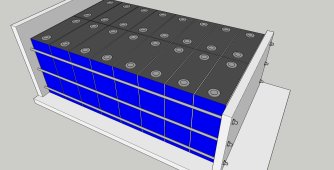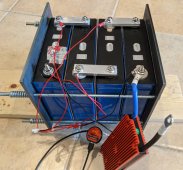I plan to use 6 rods (6mm) with M6 bolts.
If I understand correctly and if I don't make mistakes about unit conversions or translation:
I need to apply a total of 660lbs x 2 = 1320 lbs to keep it "compressed".
For 6 bolts: 1320/6 = 220 pounds at each bolt
With the
bolt calculator i found:
- 330 pounds (lbs) axial clamp force
- bolt diameter = 0.23622 in (6mm)
- torque should be set at: 10.40 in lbs (1.175 Nm) convert unit used (in lbs to Nm) for each bolt
It seems like not a lot of force, is my calcul wrong?

A better method, if your compression springs create roughly linear force through their working range, might be measure the springs instead. My own springs (4x per battery, 3 batteries) were purchased with a "maximum compression" value about 10% higher than the required force. Each Spring therefore, gets torqued down until they are 90% of the way to compressed height. (This varied according to the individual springs and the and the compression requirement, my 3 packs differ in size).
You will have a hard time finding Springs where the inner diameter is reasonably close to 6mm. On my comparable pack (4S, EVE 230Ah) I'm simply using 3/8 rod instead, purchased from a big box store. The nuts have an easier time, and the rods are stronger.
But I'm not familiar with your concept of calculating "double the load" for two sets of springs. I think you're making a mistake. If one end plate DIDN'T have springs, but simply consisted of steel plate (e.g. 1/4" steel plate) with the rods inserted through 'unsprung' holes, into a washer and nut on each one, that "plate" would still be feeling all 660 lbs from the other plate (tension via the rods, compression through the battery cells being equal).
The compression plate has the rod going through with about 2" of extra length, the spring mounted on the rod with a washer for the nut, and the tightening nut. When you tighten the nuts and compress your 6 rods TO ONLY 110 POUNDS EACH, 660 lbs of total tension occurs on the rods, and 660 lbs of compression occurs through the batteries - and through both plates.
- - -
In fact, my first battery pack has double bolts. When cells expand, the centerline (between cells 2 and 3 of the 4S battery pack) remains motionless, while both end plates move out a slight bit. My later packs have only a single set of bolts. When cells expand, they push from the "fixed" un-sprung plate, moving towards the sprung plate. The total amount of motion remains the same, but the outer face of cell #4 gets moved twice as much (in comparison to the "equal movement" result of double sets). My battery cells are free to move along the bottom of the battery pack, with only the "left" side firmly anchored to the bottom. Fewer springs = less money and slightly less total length, same compression result.
If you build with "double" springs and start to compress one of your rods by tightening just ONE of its nuts, that spring will become compressed by only half the amount of movement on that nut. The opposing spring will also compress and take equal load. When you have the right compressed spring height (my distance method) or the correct torque (your method, probably less accurate due to imperfect beveling of the Thread faces, creating "tight" spots with uneven binding forces) your pack is fully compressed. The force on each tension rod is simply your total compression divided by the number of rods - no doubling.
With springs in pairs on the same rod, the nut on the spring which you are NOT turning will gain the same torque resistance as the nut which you ARE turning, through the rod and the compression of its own spring. If you go double the distance at one end, you don't need to move the second nut at all. They will be balanced.





